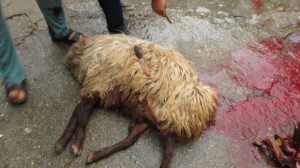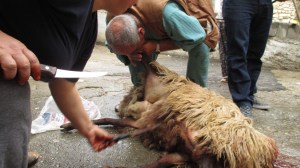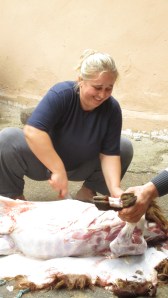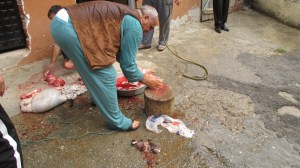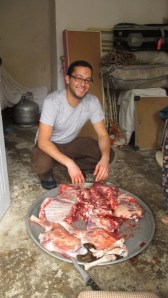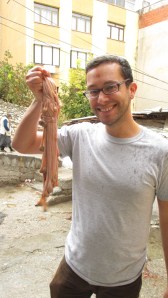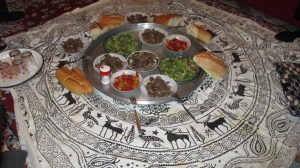We picked up Zeynep, her husband, and their son from the Turan Metro station, just past the Karşıyaka bridge, where the road turns sharply eastward towards Alsancak and the other side of the İzmir Bay.
Zeynep’s mom and dad live in Gültepe, which is east of Konak. (We previously met Turgut Bey at the hayvan pazarı) It’s before the Çevre Yolu (the perimeter freeway). The Çevre Yolu is almost exactly like I-580 in Oakland, but a more remote version. Gültepe means Rose Summit, but it was pretty much all Tepe and no Gül. A rainy night in a rental car with five people navigating steep hills is a stressful way to enter into an animal sacrifice situation.
We drove up, up, up Gültepe until we came to a street dead-ended by a staircase. The rain was steady at this time, and there were thunder rumblings.
The house was filled with aunts, uncles, and kids. One of the kids fetched a rock to place under my car tire, as the hill was dangerously steep.
Mary and I met everyone, put on our guest slippers, got our customary handful of limon kolonya, and went into the living room to drink tea and eat baklava. After 30 minutes of chit chat, it was time to initiate sacrifice sequence! Turgut Bey went into a small bedroom to pray, and then we went outside.
The sheep looked the same since I had seen him last week. He wasn’t panicked or twitchy, just calm and slightly stubborn in the way that sheep are. I started to tell him “hey buddy, it’s gonna be okay,” but cripes, he was walking the Green Mile.
My sheep had been living here for two days, in a tool shed with its own drain. Turgut Bey made sure to point out the drainage, lest I think that they were allowing the blood to run into the street.
Turgut Bey put on his butchery outfit; green pajamas with a leather vest. Looks like he stole my Halloween costume idea: Muslim Power Ranger.
Turgut Bey picked up the sheep and gently placed it on its side. Then he tied three of the legs together. Everyone gathered around to watch. I felt clumsy as I tried to hold my notebook and my camera while trying to help hold the sheep down. It was kind of like when you’re trying to give an animal a pill; you need to find that sweet spot of firm, yet compassionate force. Any excess wrangling or roughing up would be considered an “eziyet” (mistreatment) to the kurban, and my thought process was along the lines of “don’tfuckthisupdon’tfuckthisupdon’tfuckthisup.”
I had not participated in the namaz (prayer) before the sacrifice, nor was I planning on participating in the two prayers required after the sacrifice, so Turgut Bey was to kill the sheep. Since it was my purchase, the sheep was technically mine to kill. I had to formally give my vekalet (agency/representation) over to Turgut Bey so that he could perform the sacrifice. He asked me three times for my vekalet, same question each time, and then it was time to cut. The repetition reestablished the emphasis on agency transfer, and made me feel like some execution-happy Texas governor.
The knife, albeit a bit dull, had been blessed, so we couldn’t use the razor-sharp 7” boning knife I had brought along. (Helal butchery dictates the blade must be sharp, but the defintion of “sharp” is, like most religious decrees, subjective). The blade was inscribed with “Bismillah ir-rahman ir-rahim” in Arabic, meaning “The name of Allah, most gracious, most compassionate.”
Turgut Bey took the knife and placed it flat-side against the sheep’s throat. The sheep looked on plainly, definitely a bit uncomfortable, but used to being handled by people. Then the knife was dragged back and forth as if shaving the sheep’s neck, in order to smooth out the wool and locate the cut site. I was holding the sheep down tightly with Zeynep’s son and brother. Turgut Bey said “Bismillah!” and sliced the sheep. It took a few hard, directed cuts to get through the jugular and carotid, and Turgut Bey was sprayed by a meter-high blood spurt. The sheep didn’t have time to bleat, but there was a gurgling croak just as I saw the occipital condyles appear. I saw the spinal arteries, which was when Turgut Bey briefly paused to mention that those were the “can damarlari” (life veins). Technically speaking he’d cut the life veins, but as soon as the vertebral arteries were cut, the animal was, how to put it, “more dead.”
Everyone observing was calm, but not nervous or bummed out. This is a festive holiday, after all, but tinged with the solemn fact of death, of transforming a life into meat. Once the head was removed, the knife was carefully placed on top of the still-convulsing sheep’s body. The head stared at me calmly, and I saw the masseter muscles flex and relax. The knife on the sheep is meant to absorb the rest of the animal’s life. The knife is an artifact of negative-energy absorption, mirroring the ubiquitous blue evil-eye in Turkish culture.
Turgut Bey told Zeynep to put some blood on my forehead.
Turgut Bey untied the sheep’s feet, and cut into one of the rear shanks. Using a metal rod he bored a subcutaneous hole from the shank to the pelvis. He blew into the hole to loosen the skin from the muscle and gave the body a few gentle pats to disperse the air.
Skinning was a group project, with Zeynep doing most of it. Ahmet Bey, the neighbor next door and a leather tanner by trade, popped over and finished the job. He took the hide home with him after helping butcher some of the cuts.

The blood in the cavity was steaming as Ahmet and Turgut Bey explained how to remove the gall bladder from the liver.

Zeynep with the eye, which she planned to dry and keep as a souvenir. She still has her henna markings, applied on the first day of Bayram.

Opening up the stomach, aka tripe, or “işkembe.” The smell was too strong for Mary to stand this close. Turgut Bey did this to show me how well the sheep had eaten prior to sacrifice.
The meat was portioned and we retreated inside from the rain. Zeynep and her niece sat on the kitchen floor boning out the sheep legs and cubing the meat. This was for the traditional post-kurban kavurma. Kavurmak as a verb means to cook/roast/sauté. It is related to the Urdu korma. In the Indian food sense, it’s a braised meat dish, but the traditional Turkish kavurma after the sacrifice is pan-cooked meat, medium-high heat, seasoned with salt. I wanted to sit in the kitchen and take notes of the preparation, but the men beckoned us to sit with them and drink tea. The family also made me take off my ever-so-slightly damp shirt and put on a new one. It’s a little awkward to go into a room with two teenage boys whom you haven’t had a chance to meet, say hello, yank off your shirt, and expose them to one’s chest pelt. Did I say “awkward?” I meant INCREDIBLY awkward.
Zeynep’s brother and her sisters apologized for the fact that we were going to eat on the floor of the living room, as is customary in most of Turkey, and I tried to coherently explain that we also sat on the floor at home, especially during Game of Thrones night.
The spread was great; a communal plate of kavurma, bowls of yogurt-mint soup with sheep brain, salad, homemade pepper/garlic/tomato pickle relish, and bread. They didn’t cut bread with a knife, as it was günah (a sin). A tall beer would have been the best thing ever, but it was not to be, obviously. Turgut Bey had slaughtered a cow for their whole family the day before, and we got to try some beef kavurma as well.
We ate ourselves silly and the family graciously fielded all of my questions. My favorite part of the process was the neighborhood interaction. While we were outside butchering, families would walk by and wish us “İyi Bayramlar!” while kids would look on, not scared or grossed out. Is this the way my hypothesized “meat consciousness” begins manifesting itself in Turkish people? In the US we shield kids from scenes of animals dying, lumping a respectful ritual sacrifice in with stories of pre-psychopathic kids torturing cats or disgruntled housewives boiling bunnies. Even the term “butcher” is linguistically loaded; as if someone comfortable with slaughtering and breaking down animals could make the leap to humans, like a cultural form of the flu virus.
THE BUTCHERY & DISTRIBUTION
There was no Butcher Boy band saw, obviously, but I had expected to at least see a handsaw. In this environment you see how the lack of artifacts such as electricity and machine-standardization influence not only meat processing, but recipes and diets. Rough cuts of a small animal like a sheep (my guy yielded about 15-20 kg of meat) mean lots of bones and fat, which mean lots of low-heat braising dishes. This in turn influences fuel sources, pot and pan shapes and materials, and time appropriation for food preparation. Compare it to the American steak/hamburger culture, with mechanically-aided clean cuts of meat and high-energy grills and stoves. Americans (and this is a broad generalization that intentionally ignores American braising culture!) tend to like high-heat, quick cooking in general, and our meat choices/options reflect that.
If I’m cutting up a lamb like we did at The Local Butcher Shop in Berkeley, we begin the same way each time: by splitting the animal in half on a transverse, at the skinniest point of the waist. Then we plop each section on the band saw and sagitally cut it into two halves, so you end up with four sections, a limb on each one. This is more or less standard; barring any specific customer requests, we can in theory prep every lamb like this. (Shank removal is optional, and usually removed to fill out a nice braising platter, but meat keeps longer/resists oxidation in its whole form, this the benefit of cutting to order). Shoulder chops, rib chops, and loin chops are all cut on the band saw to desired thickness. If you’re feeling rustic, you can pre-cut the rib and loin chops with a big knife, and then use a cleaver-rubber mallet combo to break through the vertebral bones.
The purchaser of the kurban (that’s me!) gets to keep 1/3 of the animal. I had my mind set on the short loin; I’d get lamb loin chops! Without a saw, however, it was impossible to get the clean cuts needed for loin chops. I felt a bit crestfallen at ending up with rough cleaver cuts of loin sections with bone shards aplenty. I’m thinking of making a quick-braise, but I’m open to suggestions.
As I just mentioned, the bayram dictates that one third of the meat goes to the purchaser/purchaser’s family, one third to the extended family, and one third to the less fortunate. You are supposed to have enough meat to distribute to seven families. According to Zeynep’s family, you want to at least give one kilogram of meat to a needy family.
I asked how a less-fortunate family was designated or made known, and Zeynep’s brother explained that in a tightly-knit community, that was easily known.
We drank our coffee, offered profuse thanks, and headed home.






